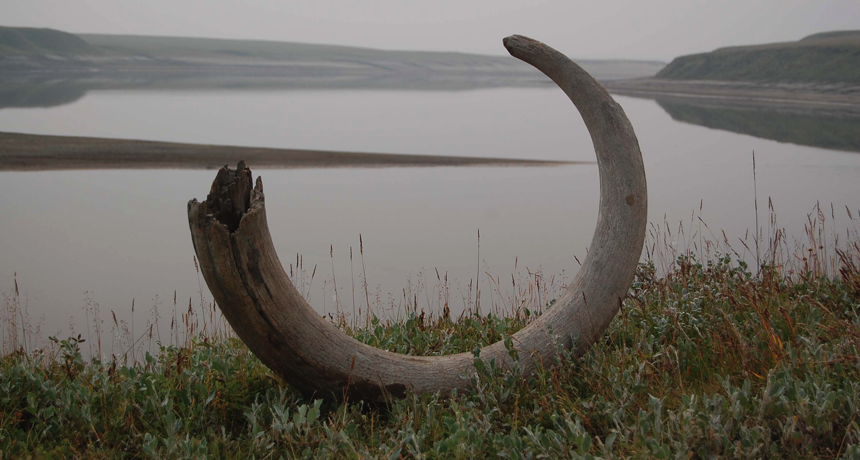Flower loss doomed the mammoths
Studies of ancient animal poop paint a new picture of why woolly mammoths disappeared

Where have all the mammoths gone? A new study suggests flowering plants called forbs sustained wooly mammoths. When forbs began vanishing from the Arctic around the end of the last Ice Age, so did the mammoths. Pictured is a mammoth tusk found in Russia.
Per Möller/Johanna Anjar
Losing much of their favorite food may have caused woolly mammoths to go extinct, a new study concludes.
Elephant-sized woolly mammoths roamed the upper reaches of North America, Europe and Asia long ago. But these plant-eating giants and other supersized animals largely disappeared by about 10,000 years ago. Researchers now think the mega-mammals might have vanished because they could no longer find enough of the plants, called forbs, on which they had dined. The abundance of these mostly flowering plants nosedived as the Ice Age began to end.
Eske Willerslev of the University of Copenhagen, in Denmark, is an evolutionary geneticist. He and his coworkers had wanted to find out what plants grew in the ancient Arctic. So they focused on plant genes. Genes tell cells how to build the molecules that make life possible.
The researchers worked with 212 samples of permanently frozen soil. Called permafrost, it can be found throughout many polar regions. The ancient soil for this study came from 21 sites in Alaska, Canada and Siberia. By comparing each soil sample’s age with the plant genes preserved within it, the scientists put together a picture of what plants had flourished at the time of the mammoths.
Researchers used to think the northern Arctic would have been a sea of grass. It now appears that between 50,000 and 12,000 years ago, this area looked more like a meadow. The mammoths roamed dry plains that would have been bursting with vibrant colors. Some of the most abundant forbs, the data show, included relatives of prairie sagewort, yarrow, chrysanthemums, asters and tansy.
But as the Ice Age ended, the abundance of forbs started to plummet. As temperatures rose, the glaciers began to thaw and the land became wetter. Woody plants such as horsetails, cotton grass, and willows liked these conditions. Forbs didn’t.
And that would have left the mammoths rather hungry, additional research shows.
To find out what mammoths and other large animals ate, the scientists studied coprolites, which are fossilized feces. The researchers also examined the preserved stomach contents found with the remains of eight giant animals, including four woolly mammoths. (The other animals: two woolly rhinoceroses, one bison and one horse.) All of these animals lived between 55,000 and 21,000 years ago.
Forbs made up 63 percent of the plant content in the animals’ poop and stomachs, it turns out. Grasses accounted for only about 27 percent. These data suggest the mammoths and other animals ate a diet that was about two-thirds forbs. If true, then mammoths would have had a hard time getting enough nutrition from the grasses and woody plants that edged out the forbs after the Ice Age.
“I’m not saying that they weren’t eating grasses, but our data suggest the forbs were sustaining them,” Willerslev told Science News. His team described its findings February 6 in Nature.
Other scientists find Willerslev’s approach to better understanding the ancient landscape exciting. However, many say blaming the mammoth die-off on too few forbs may be overly simplifying the situation.
The new genetic data are “fascinating,” says Michael Hofreiter. He is a biologist at the University of Potsdam in Germany. “If you look closer at the data,” he argues, “the story is not as straightforward as they make it.”
In fact, the biggest decline in the abundance of Arctic forbs didn’t occur until thousands of years after the mammoths and other giant animals went extinct, he says. That suggests vanishing forbs did not necessarily trigger the animals’ extinction.
Power Words
Arctic Circle The northernmost point at which the sun is visible on the northern winter solstice and the southernmost point at which the midnight sun can be seen on the northern summer solstice.
coprolite Fossilized feces. The word coprolite, in Greek, means “dung stones.” Coprolites are very important because they can provide direct evidence of what ancient creatures ate.
extinct An adjective that describes a species for which there are no living members.
evolutionary genetics The science of how plants, animals and people change over long periods of time by studying genes. Scientists who work in this field are known as evolutionary geneticists.
feces A body’s solid waste, made up of undigested food, bacteria and water. The feces of larger animals are sometimes also called dung.
forb A type of flowering plant.
glacier A slow-moving river of ice hundreds or thousands of meters deep. Glaciers are found in mountain valleys and also form parts of ice sheets.
Ice Age Earth has experienced at least five major Ice Ages, which are prolonged periods of unusually cold weather experienced by much of the planet. During that time, which can last hundreds to thousands of years, glaciers and ice sheets expand in size and depth. The most recent Ice Age peaked 21,500 years ago, but continued until about 13,000 years ago.
permafrost Permanently frozen ground.
woolly mammoth An extinct relative of elephants that was adapted to cold temperatures, with a long shaggy coat, small ears and a thick layer of fat. Individuals are sometimes found frozen in the permafrost of Siberia.







